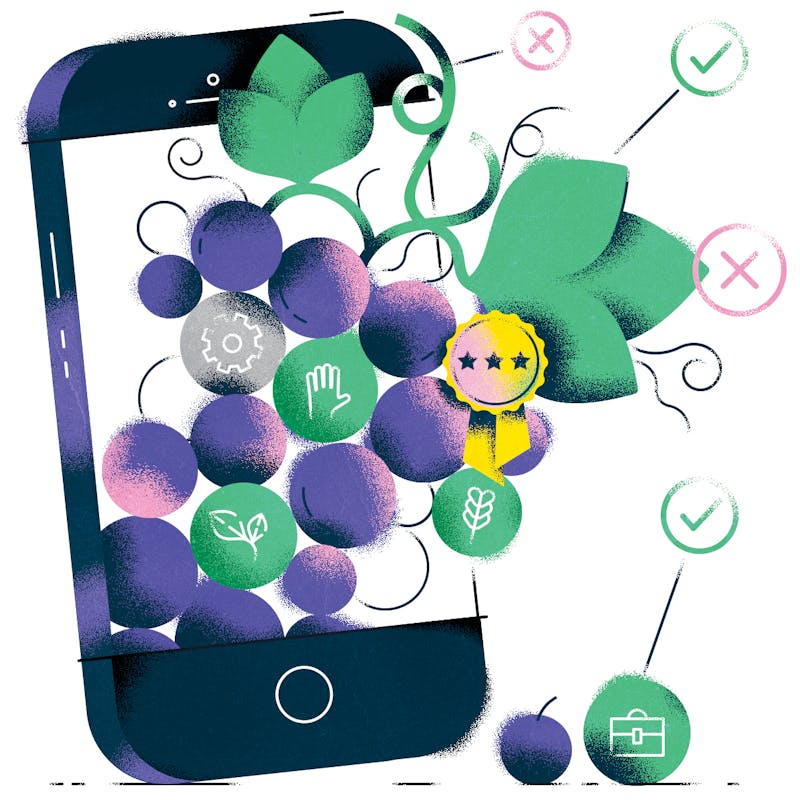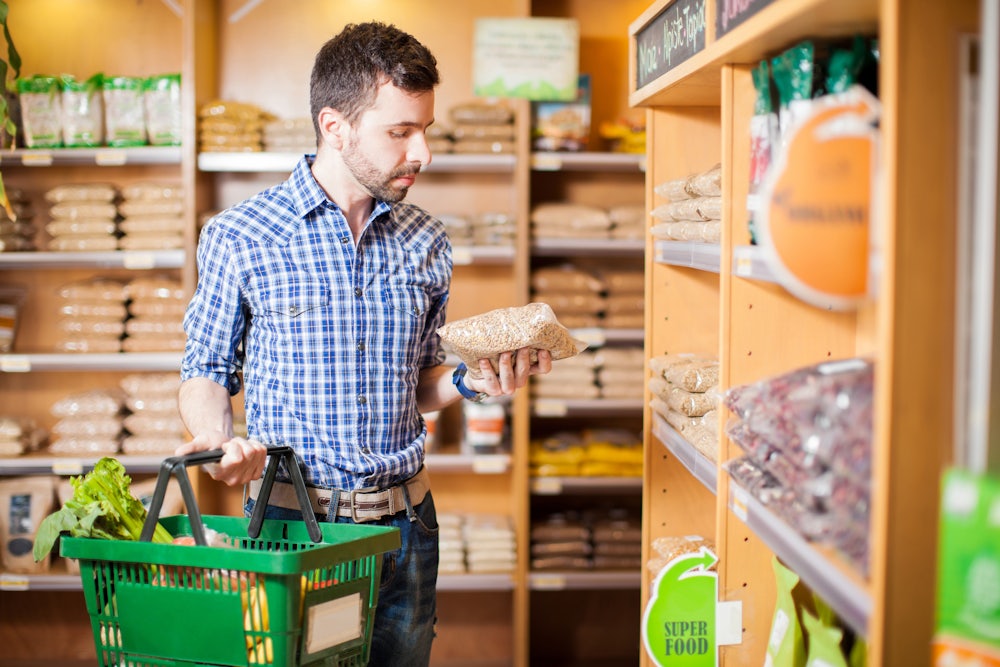Everyone knows you should be watching what you eat. But how exactly do you watch the people who grew and packaged it? How do you trust that the food you buy meets the ever-growing list of requisites for a right-minded shopper? Not just the right kind of fats in the right proportion but also low sodium, organic, GMO-free, with no added sugars or artificial colors or whatever has been high on your nutritional priorities lately. Try factoring in how the animals were raised, on what kind of land, and what they were fed, how the people who work in the company are paid and where they get their health care, how much fuel the trucks use to get to the market, whether the boxes or labels use recycled material, whether their subcontractors pay health insurance and attend town meetings. ... Once you start, it’s hard to stop. How to keep track of everything you want in the way your food is produced? Check the backs of food boxes and cans and you’ll encounter a fairly limitless mystery of symbols and marks and scores (around 350 potential certifications, according to one estimate). It’s exhausting just to think about.
HowGood, a company that wants to put seals of approval on supermarket shelves all across the land, tries to do that work for you. It evaluates products by 70 “indicators,” or criteria, that have very little to do with nutrition and everything it can think of to do with sustainability, fairness, food justice, and environmental and worker safety. It covers more than 170,000 products so far, using data from hundreds of publicly available sources and also from seven researchers working in a purple barn in upstate New York, who pick up the phone to ask manufacturers questions they can’t find the answers to on the web.
It has an app, yes. Everybody has an app. But nobody uses apps to scan codes to see what went into a product on a shelf. Companies like to make promises of transparency with bar codes and QR codes, knowing full well that constantly rushed consumers are almost certain not to bother to train a phone camera on a code, hold still to snap a picture, and wait for the results to show up. (Food manufacturers who don’t want GMO labeling say they’ll put all the information anyone could want in codes: Why distract consumers with yet one more piece of complicated information on a label? Let them find the scanner app on their phone and figure out how it works.)

Cynical or not, the unlikelihood of consumers using apps and the difficulty of making money from them explains why there are few well-known rivals to HowGood on the market. Perhaps the best-known, ShopWell, is mostly for helping with diet choices (“a personal nutritionist in your pocket!” the iTunes downloads page claims). Naomi Starkman, a founder and the editor-in-chief of the invaluable web site Civil Eats, has been spending the academic year as a John S. Knight fellow at Stanford, researching whether millennials who call themselves food—focused actually use their phones while shopping. The results of her early research? They don’t. But they don’t trust current labels or most of those 350 symbols, either. “They feel overwhelmed by the amount of information coming at them,” she said, “and often make very subjective, emotional decisions around food, many of which are moment-to-moment and mercurial and not connected to online guides, apps, ratings, or technology.”
This leaves would-be raters in a tough spot. A kind of old-fashioned spot, in fact. HowGood earns revenue not on its app—it doesn’t even try—but on fees from supermarkets that place its rating symbols right on the shelves, to help guide shoppers making those mercurial, moment-to-moment decisions. A quick answer about the way the company treats animals and the people who raise them and the land they’re raised on. Sounds simple, no?
Of course it isn’t. When I first visited the two brothers who founded HowGood, Alexander and Arthur Gillett, nearly three years ago, they brought me to the one store in New York City that used their labels, a then brand-new supermarket in Long Island City called Foodcellar & Co. I liked the idea of seals of approval below products, especially when I could compare like with like. But the system has serious limits: The three round seals, featuring drawn bouquets of flowers and grains, say “good,” “great,” and “best.” No “bad,” “even worse,” or “downright lousy.” The absence of a seal below a product could mean that it simply wasn’t rated—or that it was, and it was found wanting.
Why the good cheer and speechlessness? Supermarkets don’t want to discourage sales of anything they put on shelves. This is what stops any ratings with teeth from getting on labels: After the British government succeeded in placing a front-of-pack stoplight system, with red, yellow, and green for calories, sugar, saturated fat, and salt, the European Commission tried to end it. Manufacturers are glad to call out certain nutritional criteria in thumbnail symbols on the front of packages—but only if the news is good, and never when it is bad. Even Guiding Stars, the best supermarket-product-rating system I’ve seen, at the New England stores of the Hannaford chain, only has rankings of “good,” “better,” and “best” for “nutritional value.” The supermarket business may be vast—even a relatively modest 150-store chain, Alexander Gillett recently told me, has a turnover of $3 billion a year—but it operates on a 1 percent margin. So the many, many certifiers trying to get toeholds in chains face a steep uphill climb. Only gutsy health departments, like those in New York City and Los Angeles, dare require bad grades to be posted in restaurant windows, and that’s by law.
Thus when I recently visited HowGood’s sunny, fourth-floor walk-up offices in the Greenpoint section of Brooklyn the labels still weren’t in any more New York City stores. Progress had been tenfold in the years since my visit—almost 200 stores, compared to the 20 when I first visited. But the overall number is small, and the stores aren’t in the places you’d expect them—Boston, say, or San Francisco. A big blue map of the U.S. showed pinned triangular flags where HowGood had landed a store, with Alaska cutely painted high above the map and Hawaii alone on a side wall. It was very, very spotty—huge swaths of the Northeast and middle of the country unpinned, and little flags in Texas, for instance, where HowGood is in trial periods with two 150-store chains. Why did they never get into, say, Whole Foods, the most obvious place for their system? HowGood did have a meeting at the chain’s Austin headquarters, Alexander told me. But Whole Foods decided to implement its own evaluation criteria—logical for a company with its own purchasing avenues, but leaving customers at the mercy of the criteria the store picks, much like the investors who try to find corporate social responsibility ratings in a sea of entirely self-reported results.
Still, the brothers are persevering. They have raised over $2 million in seven fundraising rounds, plus initial seed money and their own investment, and the staff now totals 21. Sales lures include the first three months free, a promised increase in sales of 4 percent per purchase—a big claim, and as much as a 36 percent increase for “best” rated products. Those are sales cannibalized from other products in the store, Alexander Gillett admits; but the average “best” comes at a premium, which helps explain the claimed overall 4 percent sales boost. HowGood rankings, its sales team says, will help stores see the 72 percent buy-in of consumers who said in a Wall Street Journal survey that they would spend more for “better for the world products.” These are increased sales that stores won’t see, the pitch continues, unless consumers have the tools to figure out which products really are better for the world.
Like Starkman’s millennials, I have no plans to whip out my cell phone in a store to see whether I can feel virtuous about buying one thing over another. So I’m taken with the idea of HowGood, as partial as its labels will be at any participating market, and like the idea of objective criteria, or at least evaluations from a third party. But until the brothers make more headway, the likeliest solution will be to find community markets whose owners you trust to stock products they believe in—stores like the cult Bi-Rite, in San Francisco, or the godfather of them all, Zingerman’s, in Ann Arbor. And these are in fact members of a group of markets assembled by Sarah Weiner, originator of the Good Food Awards, which promote products that meet a list of criteria that’s smaller than yet similar to HowGood’s—but with a clear emphasis on flavor, which HowGood sidesteps. So far, the group of stores numbers just 17, Weiner told me, and stores must be 51 percent owned by families, individuals, or workers. She plans to limit the number to 30. It’s stores like these that will be easiest—if not cheapest—for the food-conscious millennials Starkman and others are scrutinizing, where the roof constitutes an umbrella of virtue. I’ll most enjoy feeling virtuous by supporting the people who run and work in the store, and knowing they’re treated well—the invisible label that matters most to me.
